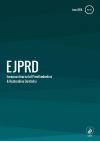European Journal of Prosthodontics and Restorative Dentistry
A 10-Year Clinical Evaluation of Resin-Bonded Fixed Dental Prostheses on Non-Prepared Teeth
Abstract
European Journal of Prosthodontics and Restorative Dentisty (2016) 24, 164–168
Keywords
Dental Implants
Zirconia
Prosthesis Failure Analyses
Periprosthetic Fractures
Dental Implant-Abutment Design
Dental Porcelain
Fracture of Zirconia
Abutment with Metallic
Insertion on Anterior Single
Titanium Implant with
Internal Hexagon: Retrieval
Analysis of a Failure
Authors
Prof. Marco Antonio Bottino *
(DDS, MSD, Chairman)
Dr Regina Furbino Villefort Rocha *
(DDS, MSD, PhD student)
Dr Lilian Costa Anami *
(DDS, MSD, PhD)
Dr Mutlu Özcan §
(Dr Med Dent, PhD)
Dr Renata Marques de Melo *
(DDS, MSD, PhD)
Address for Correspondence
Dr Regina Furbino Villefort Rocha *
Email: [email protected]
* São Paulo State University, Institute of Science
and Technology, Department of Prosthodontics
and Dental Materials, São José dos Campos,
Brazil
University of Zurich, Head of Dental Materials
Unit, Center for Dental and Oral Medicine, Clinic
for Fixed and Removable Prosthodontics and
Dental Materials Science, Zurich, Switzerland
§
ABSTRACT
This case report presents a retrieval analysis of a screw-retained one-piece restoration
with the veneering ceramic fired directly onto the zirconia abutment that fractured during insertion. A patient who experienced root fracture of a maxillary left central incisor
received a titanium implant on the same day as extraction. After delayed implant loading, a two-piece zirconia abutment with metallic insertion was customized. Upon installation, a horizontal fracture of the crown just above the metallic portion was detected.
The retrieval analysis of a fractured zirconia abutment showed crack formation and diffusion of glaze material that expanded the crack line during firing.
INTRODUCTION
Patients expect success when replacing a lost dental element in the anterior region, and this requires careful planning. Currently, there are several
treatment options for the restoration of missing anterior teeth, and clinicians should choose a predictable treatment based on scientific evidence.
The use of implants for tooth restorations was first reported three decades
ago as a treatment option for partially or fully edentulous patients.1 Since
then, metal alloys, mainly titanium, have been accepted as reliable, biocompatible substructures for implant-supported crowns. However, their
gray appearance may compromise aesthetics, especially after bone resorption. Furthermore, peri-implant soft-tissue recession may lead to exposure of the metallic abutment. For this reason, abutments of aluminum
oxide or zirconium are often selected to circumvent this issue,2 since they
are more aesthetic and fulfill biocompatibility requirements.2,3
Alumina and zirconia abutments have high fracture resistance and allow
light to pass through, thus improving aesthetics.4-8 Most implant manufacturers today offer zirconia abutments for implant-supported metal-free
restorations, to meet the demand for aesthetics. Such abutments are currently available in prefabricated or custom forms and may be prepared
either by the dental technician through drilling or by computer-aided-design/computer-aided-manufacturing (CAD/CAM) systems via milling techniques.3
Received: 26-03-2016
Accepted: 20-04-2016
doi:
• • • • • • • • • • • • • • • • • • • • • • • • • • • • • • • •
EJPRD
Authors
Nobuo Nakabayashi, Franklin Garcia-Godoy, Mutlu Özcan, Morakot Piemjai
Articles from this issue
| Title / DOI | Access | Page Start | Page End | Purchase |
|---|---|---|---|---|
| An Investigation Into the Integrity of Fit of Provisional Crowns Using Current Proprietary Temporary Crown Materials 10.1922/EJPRD_1442Taylor08 |
|
50 | 57 |
£10.00 |
| Oral Health Status of Patients Undergoing Treatment for Head and Neck Oncology in Northern Ireland 10.1922/EJPRD_1497Moore05 |
|
58 | 62 |
£10.00 |
| A 10-Year Clinical Evaluation of Resin-Bonded Fixed Dental Prostheses on Non-Prepared Teeth 10.1922/EJPRD_1493Piemjal08 |
|
63 | 70 |
£10.00 |
| The Effect of a Radiation Positioning Stent (RPS) in the Reduction of Radiation Dosage to the Opposing Jaw and Maintenance of Mouth opening after Radiation Therapy 10.1922/EJPRD_00005Nayar07 |
|
71 | 77 |
£10.00 |
| Zirconia Rehabilitation Focused on the Emergence Profile: A Case Report 10.1922/EJPRD_1521Rodrigues08 |
|
78 | 85 |
£10.00 |
| The British Society of Prosthodontics 2016 Conference: Manchester |
|
86 | 88 |
£10.00 |
| Abstracts |
|
89 | 117 |
£10.00 |
| Presentation & photos 2016 |
|
118 | 120 |
£10.00 |
 Free Access
Free Access No Access
No Access Full Access
Full Access


